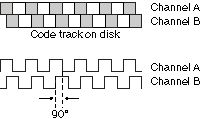
Quadrature encoders are one of the most common types of encoder. They are often referred to as A quad B, or incremental encoder. Quadrature encoders are incremental, meaning that they can accurately measure changes in position, but cannot provide an absolute position.
Quadrature encoders are often used on motors. They are also commonly used to provide a reference input, such as the position of a belt, or the position of a board on a flying cut-off application.
Quadrature feedback is supported by the following modules:
RMC200: Q4 Module, S8 Module, D24 Module, U14 Module
Delta recommends an RS-422 line driver output for quadrature encoders, as it provides the highest speed and very good noise immunity. The TTL and HTL input types supported by the D24, Q4 and U14 are intended for retrofit applications where an existing encoder cannot easily be changed to RS-422. RS-422 is also commonly referred to as a 5V differential signal (although that is not the strict definition).
Operation
A and B Signals
Quadrature encoders use two output channels (A and B) to indicate position. Using two code tracks with sectors positioned 90 degrees out of phase, the two output channels of the quadrature encoder indicate both position and direction of rotation. If A leads B, for example, the disk is rotating in a clockwise direction. If B leads A, then the disk is rotating in a counter-clockwise direction.
By monitoring both the number of pulses and the relative phase of signals A and B, both the position and direction of rotation can be tracked.

The resolution of quadrature encoders is typically given in Pulses per Revolution (PPR), also called Lines per Revolution. The RMC feedback sees each rising or falling edge of the A or B signal as one count. Therefore, each pulse or line of the encoder will result in four counts on the RMC feedback. For example, a 1000 PPR encoder will give the RMC 4000 counts per revolution.
The RMC increments the counts register when A leads B. It decrements the counts register when B leads A.
Index Pulse
Some quadrature encoders also include a third output channel, called a zero or index or reference signal, which supplies a single pulse per revolution. This single pulse is used for precise determination of a reference position. The RMC75 QA, RMC150 Quad, and RMC200 Q4, U14, and D24 modules support an Index (Z) pulse input; the RMC75 Q1 and RMC200 S8 modules do not.
When using the Index (Z) pulse for homing, the Index (Z) Home Location must be set to specify the edge of the quadrature A signal on which a Z home is triggered. See the Homing topic for details.
Homing Quadrature Axes
Quadrature encoders do not provide absolute position. To use a quadrature encoder in a position application, a known reference position must be established. This position is referred to as the Home position. The process of moving the axis to find the home position is called Homing. Once the Home position is established, the encoder increments or decrements the position from the initial home position as it rotates.
There are several methods of homing. Typically, it involves moving the axis to a proximity switch that then sends a signal to the RMC. The RMC sets the position at that precise point to whatever value the user requested. The index pulse can also be used for homing.
For details on homing, see the Homing topic.
Registration
Registration is the process of recording the precise position of an axis when an external event occurs. Registration is commonly used for measurements. For example, consider a photo-eye set up on a conveyor belt, where the position of the belt is measured with a quadrature encoder. By registering the precise position at which the photo-eye is broken and the precise position at which it is reconnected, the length of a widget on the belt can be accurately determined.
The RMC provides registration on quadrature feedback axes only. This is because quadrature feedback is the only type of feedback that can record a position at any given moment, independent of the loop time of the RMC. All other feedback types can only report the position once each loop time (500μs to 4000μsec).
For more details, see Registration.
See Also
Feedback Resolution | Wiring Guidelines
Copyright © 2025 Delta Computer Systems, Inc. dba Delta Motion